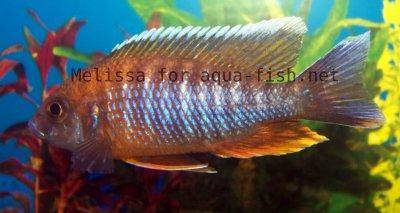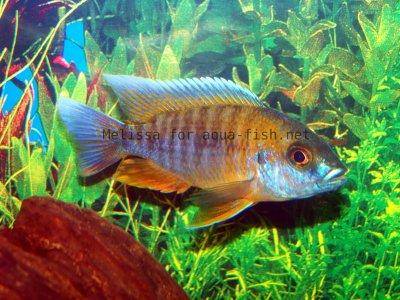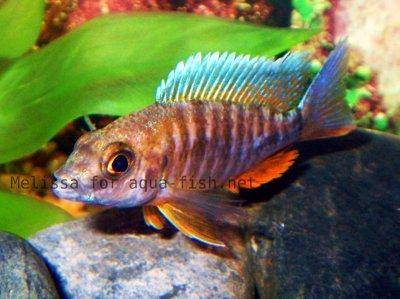Comprehensive Guide to Peacock Cichlid (Aulonocara) Care, Breeding, and Habitat
Quick Links - Answers
- Physical Description and Size
- Natural Habitat and Tank Setup
- Ideal Water Conditions
- Aquarium Tank Size and Setup
- Dietary Needs and Feeding
- How to Sex Peacock Cichlids
- Breeding Peacock Cichlids
- Raising Fry and Care
- Compatible Tankmates
- Common Health Issues
- Are Peacock Cichlids Suitable for Beginners?
- Overview of Aulonocara Species
- FAQs: Questions and Answers
Brief Description
The Peacock Cichlid, belonging to the genus Aulonocara, is a vibrant and peaceful species, making it a favorite among aquarium enthusiasts. This article covers everything from habitat requirements and water conditions to breeding tips and diet. Share your experiences and questions at the bottom of this page!
Physical Description and Size
Peacock Cichlids reach lengths between 4 - 6 inches (~ 10 - 15 cm). They exhibit a variety of striking colors such as blue, orange, red, yellow, and grey, and have an elongated body shape with vertical stripes. The males are more vibrant, while females tend to have subdued, silvery coloration.
Natural Habitat and Tank Setup
The Peacock Cichlids are native to Lake Malawi in the East African Rift Valley. Lake Malawi is known for its clear, hard, and alkaline waters, along with sandy and rocky terrains. These fish typically inhabit open water and sandy bottoms, although some species also dwell near rocky outcrops.
To replicate their natural habitat in an aquarium, use a sandy substrate, and add rocks for hiding and territorial purposes. Incorporating hardy plants such as Anubias, Java Fern, and Vallisneria can provide natural decor while withstanding the cichlids' digging behavior.
Ideal Water Conditions
Aulonocara cichlids thrive in water with a pH between 7.5 - 9.0 and temperatures of 75 - 81°F (~ 24 - 27°C). To maintain these conditions, it’s essential to use proper filtration, regularly test water parameters, and perform frequent water changes. Weekly monitoring of carbonate hardness (KH) is recommended to ensure stable pH levels. While a KH of 4 dKH can be sufficient to maintain a stable pH, it leaves little room for fluctuations. A KH of 6 dKH is recommended, as it provides a buffer that can drop to 5 or even 4 before the pH becomes unstable. A KH of 5 is also doable but requires closer monitoring to prevent potential drops that could affect the fish's health.
Aquarium Tank Size and Setup
A 50-gallon (~ 190 liters, 42 Imperial gallons) or larger tank is recommended to provide ample swimming space and reduce territorial disputes. Arrange rocks and caves along the sides and back of the tank to create hiding spots. Hardy plants like Anubias, Java Fern, Vallisneria, and Hornwort are suitable for aquascaping, as they can tolerate the cichlids' digging habits.
Dietary Needs and Feeding
Peacock Cichlids are omnivores. A varied diet of high-quality flake or pellet food, supplemented with live or frozen protein sources like bloodworms, snails, and brine shrimp is essential. Feeding them two to three times a day in small portions helps maintain their vibrant coloration and health. Avoid feeding them foods that are high in fat, as this can lead to health issues.
How to Sex Peacock Cichlids
Male Peacock Cichlids are more colorful and have “egg spots” on their anal fins, which play a crucial role during breeding. Females are generally more muted in color, with a brownish-grey or silvery appearance. Males become distinguishable from females upon reaching sexual maturity, around six months old.
Breeding Peacock Cichlids
Breeding Peacock Cichlids can be rewarding, but it requires specific conditions to be successful. As ovophile mouth brooders, the female carries the eggs in her mouth for incubation after mating. To initiate breeding, it is advisable to set up a dedicated breeding tank with a sandy substrate and flat rocks.
During courtship, the male digs a pit in the substrate to attract the female. The female lays her eggs in the pit and immediately picks them up in her mouth. The male then displays his "egg spots," and the female attempts to collect them, triggering the male to release sperm for fertilization.
The female holds up to 50 eggs in her mouth for approximately 21 days. During this period, she refrains from eating, so it is advisable to separate her into a breeding tank to reduce stress. After the fry are released, they will often return to the mother’s mouth for protection until they are ready to fend for themselves.
Raising Fry and Care
Once hatched, the fry will absorb their yolk sacs and are ready for feeding. Newly hatched brine shrimp or powdered fry foods like "First Bites" are ideal. The fry should be separated from larger fish to avoid predation and provided with frequent small meals to ensure healthy growth. It is also important to maintain excellent water quality with frequent water changes in the fry tank.
Compatible Tankmates
Peacock Cichlids do well with other peaceful cichlids and bottom dwellers of similar size. Ideal tankmates include other Aulonocara species, Electric Yellow Cichlids, and larger tetras. Avoid keeping them with overly aggressive species or fish small enough to be eaten, as Peacock Cichlids might display predatory behavior towards smaller fish.
Common Health Issues
Peacock Cichlids are generally hardy but can suffer from common cichlid diseases like Malawi bloat, ich, and fin rot. Maintaining clean water conditions, avoiding overfeeding, and providing a stress-free environment are key to preventing these issues. Monitoring carbonate hardness (KH) helps stabilize pH, preventing sudden fluctuations that can stress the fish and make them susceptible to illnesses.
Are Peacock Cichlids Suitable for Beginners?
Peacock Cichlids are generally considered suitable for aquarists with some experience, rather than complete beginners. Their need for specific water parameters, large tank sizes, and understanding of territorial behavior requires a bit more care and knowledge. However, for dedicated hobbyists willing to learn and invest time in their maintenance, they can be a rewarding choice. Weekly water testing and monitoring of carbonate hardness (KH) are crucial for their well-being.
Overview of Aulonocara Species
- Chitande Aulonocara - Aulonocara ethelwynnae
- Firebird Cichlid - Aulonocara hansbaenschi
- Grants Peacock Cichlid - Aulonocara stuartgranti
- Lake Malawi Butterfly Cichlid - Aulonocara jacobfreibergi
- Midnight Peacock - Aulonocara hueseri
- Aulonocara maulana
- Nyasa Peacock - Aulonocara nyassae
- Ruby Red Peacock - Aulonocara rubescens
- Sunshine Peacock - Aulonocara baenschi
- Sunshine Peacock - Aulonocara maleri
FAQs: Questions and Answers
-
When do Peacock Cichlids get their color?
Answer: Peacock Cichlids develop their vibrant coloration around six months of age, once they reach sexual maturity.
-
How often should I feed my Peacock Cichlid?
Answer: Feed them two to three times a day in small portions to ensure they maintain their health and coloration.
-
Can Peacock Cichlids live with other fish?
Answer: Yes, they can coexist with other peaceful cichlids and larger, non-aggressive fish. Avoid small or overly aggressive species as tankmates.
-
How often should I test water parameters for Peacock Cichlids?
Answer: It's advisable to test water parameters, including pH and carbonate hardness (KH), on a weekly basis to ensure stable conditions for your cichlids.
Sources
- Focus on Freshwater Aquarium Fish by Geoff Rogers and Nick Fletcher
- The Encyclopedia of Aquarium Fish by Dick Mills






